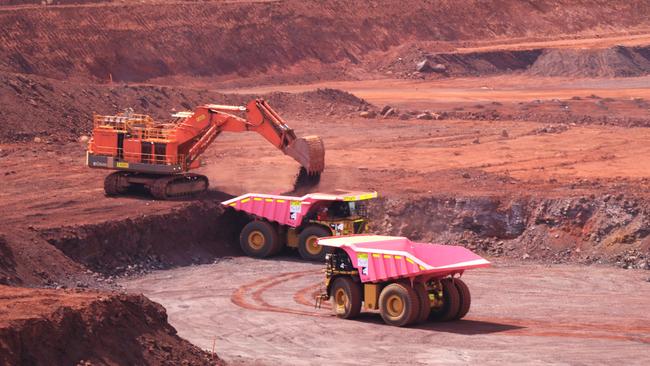Mining magnate Rinehart nabs $2.8bn iron ore windfall
Australia’s richest person, Gina Rinehart, has bulked up her fortune, snaring a $2.8bn windfall from her flagship Roy Hill iron ore operations.

Australia’s richest person Gina Rinehart has snared a $2.8bn payday in the latest bumper dividend from her flagship iron ore operations as she warns Australia is at risk of falling behind other mining jurisdictions due to poor policy settings.
The Roy Hill mine delivered a whopping $4bn dividend on the back of record shipments and a jump in revenue in 2023-24, handing Mrs Rinehart a $2.8bn share, given Hancock Prospecting’s 70 per cent share of the operations.
Roy Hill reported a net profit after tax of $3.23bn, compared to $2.7bn last year, according to accounts lodged on Tuesday.
Mrs Rinehart said the result had been achieved in the face of federal and state policy settings that threatened investment in Australia.
She said the mining industry was being saddled with “higher regulatory burdens and bureaucratic risk and expense which delay, or prevent, new projects”.
“The threat of competition from other nations is real, particularly if they are able to operate with less government tape, less approvals systems, and less government cost burdens,” she said. “Australia’s increasing government intervention, combined with ideological and expensive or impractical policies, is negatively affecting new mining investment, which reduced investment will lead to lower living standards.”
Mrs Rinehart’s warning comes as Rio Tinto is poised to start blending high-grade iron ore from the Simandou project in Guinea with the lower grade mine iron ore it is now producing from its Pilbara mines.
Hancock Prospecting is keen to see Rio develop more mines under their Hope Downs partnership that so far involves the Hope 1, Hope 4 and Baby Hope mines.
Roy Hill shipped 64 million tonnes of iron ore from Port Hedland, up slightly from 63.3 million tonnes in 2022-23.
Mrs Rinehart and the executive team at her private company, Hancock Prospecting, have a massive war chest as they look to next decade and life after Roy Hill.
It is estimated there may be only eight years of life left in Roy Hill, unless Hancock can tap into satellite deposits or resorts to processing low-grade stockpiles.
Hancock’s share of this year’s dividend pool was $2.8bn. It owns a 70 per cent stake in the mine alongside Marubeni (15 per cent), POSCO (12.5 per cent) and China Steel Corporation (2.5 per cent).

Roy Hill reported paying $665 million in state royalties and native title royalties in 2023-24 on top of $1.4bn in corporate tax.
The company spent $542m on expanding its autonomous haulage fleet, mine and rail renewal and on new infrastructure.
Hancock Prospecting chief executive of operations, Gerhard Veldsman, pointed to productivity gains as factors behind Roy Hill’s increased profit.
“Corporate profits are essential to investment and enabling higher living standards,” he said. Mr Veldsman said “timely and practical government approvals” would be a factor in any decisions around re-investment.
“As Mrs Rinehart has previously warned, the Roy Hill mine life is finite and expected to end in the early 2030s without further investment, which requires timely and practical approvals,” he said.
“Unnecessarily long, duplicative and even contradictory conditions and processes at the state and federal level impose significant costs and must be cut to ensure that the mines of the future can be developed.”
In a move welcomed by Woodside and others in the resources industry but condemned environmental groups, the West Australian government recently moved to abandon assessing greenhouse gas emissions from major projects covered by the Albanese government’s Safeguard Mechanism.

The decision saw greenhouse gas conditions imposed on Roy Hill and another Hancock-owned mining projects fall aside.
However, Hancock recently opted to delay a big investment in magnetite production in WA based on uncertainty over approvals and water supply. The company said that except for the McPhee iron ore project, its Atlas Iron division had now executed a $700m strategic growth plan announced in 2021-22.
Atlas made a $440m profit in 2023-24 on the back of an increase in shipments and revenue.
Mrs Rinehart said Australia should follow the lead of other countries and introduce special economic zones.
“It is critical that our politicians and governments implement ways to encourage business to grow and invest in Australia, such as to introduce special economic zones, with less government tape, and less tax, or tax rebates,” she said.
Mrs Rinehart has railed against government red and green tape since fighting a long battle to bring Roy Hill to life.
The mine eventually opened in 2015 and made enough cash to pay down a $10bn debt after just five years in operation, and declared a maiden dividend of $475m in 2020.
Mrs Rinehart in August raised concerns over the ability of renewable energy to replace baseload coal and gas, saying “humungous” spending would be needed on solar and wind as Australia’s electricity grid faced an uncertain path to green power.



To join the conversation, please log in. Don't have an account? Register
Join the conversation, you are commenting as Logout